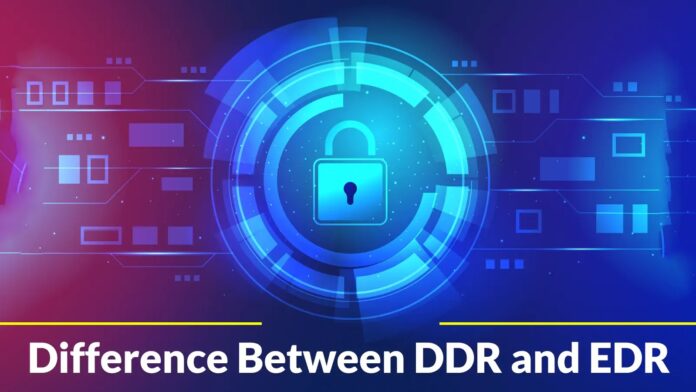[ad_1]
Cybersecurity is infamous for its acronyms. From APT to ZTNA, it is easy to get bogged down in the quagmire of jargon that, whether we like it or not, comes with the territory. This problem worsens when we come across nigh-on identical acronyms, DDR and EDR, for example.
However, organizations must understand what these acronyms mean and how they differ.
It’s no secret that the cybersecurity vendor market is saturated; security decision-makers need to know precisely what they require to avoid purchasing the wrong solution.
Data Detection and Response (DDR) and Endpoint Detection and Response (EDR) are often confused. While they do share some similarities, they are, in fact, distinct tools with distinct purposes.
This article will explore the key differences between DDR and EDR.
What is Data Detection and Response?
In real-time, DDR solutions detect and respond to threats and anomalies within an organization’s data environment.
By combining data security, threat detection, and incident response elements, DDR provides a comprehensive strategy for identifying and mitigating data breaches and security incidents.
DDR’s data monitoring and analytics capabilities identify any unusual or suspicious behavior that may indicate a security breach. DDR solutions monitor data access, transfers, user activities, and system events to establish a baseline of normal behavior and alert security teams of deviations from the norm.
DDR solutions work in five stages:
- Data Collection – DDR solutions gather and centralize data from various organizations’ sources, such as network logs, system logs, database logs, and user activities.
- Data Analysis – Using advanced analytics techniques like machine learning (ML), DDR solutions analyze the collected data and identify potential threats or anomalies. This analysis often involves correlating disparate data points to detect patterns and indicators of compromise.
- Threat Detection – DDR solutions apply predefined rules, signatures, and algorithms to detect known threats and suspicious activities, comparing the collected data against known attack patterns or indicators of compromise.
- Incident Response – Once a DDR solution has detected a threat or anomaly, it triggers an incident response plan, assessing the severity and impact of the incident, containing the threat to prevent further damage, and initiating mitigation measures.
- Remediation and Recovery – Once DDR has contained the incident, organizations work on remediating vulnerabilities, addressing compromised systems, and recovering from any potential data loss or disruption.
DDR’s primary goal is to minimize the time between detecting and responding to a security incident, thereby reducing the potential impact of data breaches and other cybersecurity threats.
DDR solutions focus on proactive monitoring, continuous analysis, and swift response to emerging threats to protect critical data and maintain an organization’s security posture.
What is Endpoint Detection and Response?
EDR solutions also detect and respond to threats and anomalies solely at the endpoint level.
Endpoints are any individual devices – a computer, laptop, server, or mobile device, for example – that connect to a network. Unlike DDR, which covers an organization’s entire data environment, security teams directly install EDR solutions on endpoints to provide real-time visibility, threat detection, and incident response capabilities.
EDR solutions work to improve an organization’s:
- Endpoint Visibility – EDR solutions provide organizations with comprehensive visibility into endpoint activities such as process execution, file changes, registry modifications, network connections, and other endpoint-related events. This visibility empowers security teams to monitor and analyze endpoint behavior and identify potential security incidents.
- Threat Detection – Through various techniques such as behavioral analytics, machine learning, and threat intelligence, EDR solutions identify deviations and anomalies that could indicate endpoint security threats, such as malware infections, unauthorized access attempts, or the presence of advanced persistent threats (APTs).
- Incident Response – Once EDR detects a potential endpoint threat, it alerts the security team in real-time, allowing them to investigate and respond. The best EDR tools offer incident response capabilities such as threat containment, compromised endpoint isolation, forensic data analysis, and system remediation.
- Forensic Analysis – EDR solutions store detailed endpoint activity logs and capture forensic data to empower security teams to perform in-depth analysis after an incident. This analysis can help identify the root cause, extent, and associated indicators of compromise (IOCs) or attack patterns.
- Threat Hunting – EDR solutions allow security analysts to search for suspicious activities or indicators across endpoints, utilizing advanced search capabilities, historical data queries, and conducting investigations to identify potential threats that may have evaded initial detection, thus supporting proactive threat hunting.
Key Differences Between DDR and EDR
DDR and EDR’s key differences lie in their respective scope and visibility. DDR monitors a broader range of data-related activities and security events across an organization’s entire data environment, including network traffic, user activities, and data transfers, while EDR focuses specifically on endpoints, monitoring activities such as process execution, file changes, registry modifications, network connections, and other endpoint-specific events.
DDR solutions provide security teams with insight into an organization’s overall data security landscape, whereas EDR offers clear visibility into individual endpoints, allowing for granular threat detection and response.
Through endpoint telemetry, behavior monitoring, and threat intelligence integration, EDR solutions detect and respond to endpoint-specific threats such as malware infections, advanced persistent threats, or suspicious activity.
DDR focuses on data-centric security, while EDR focuses on threats specifically at the endpoint level. While both are worthwhile as standalone solutions, they are most effective as part of a comprehensive cybersecurity strategy.
[ad_2]
Source link


.png
)